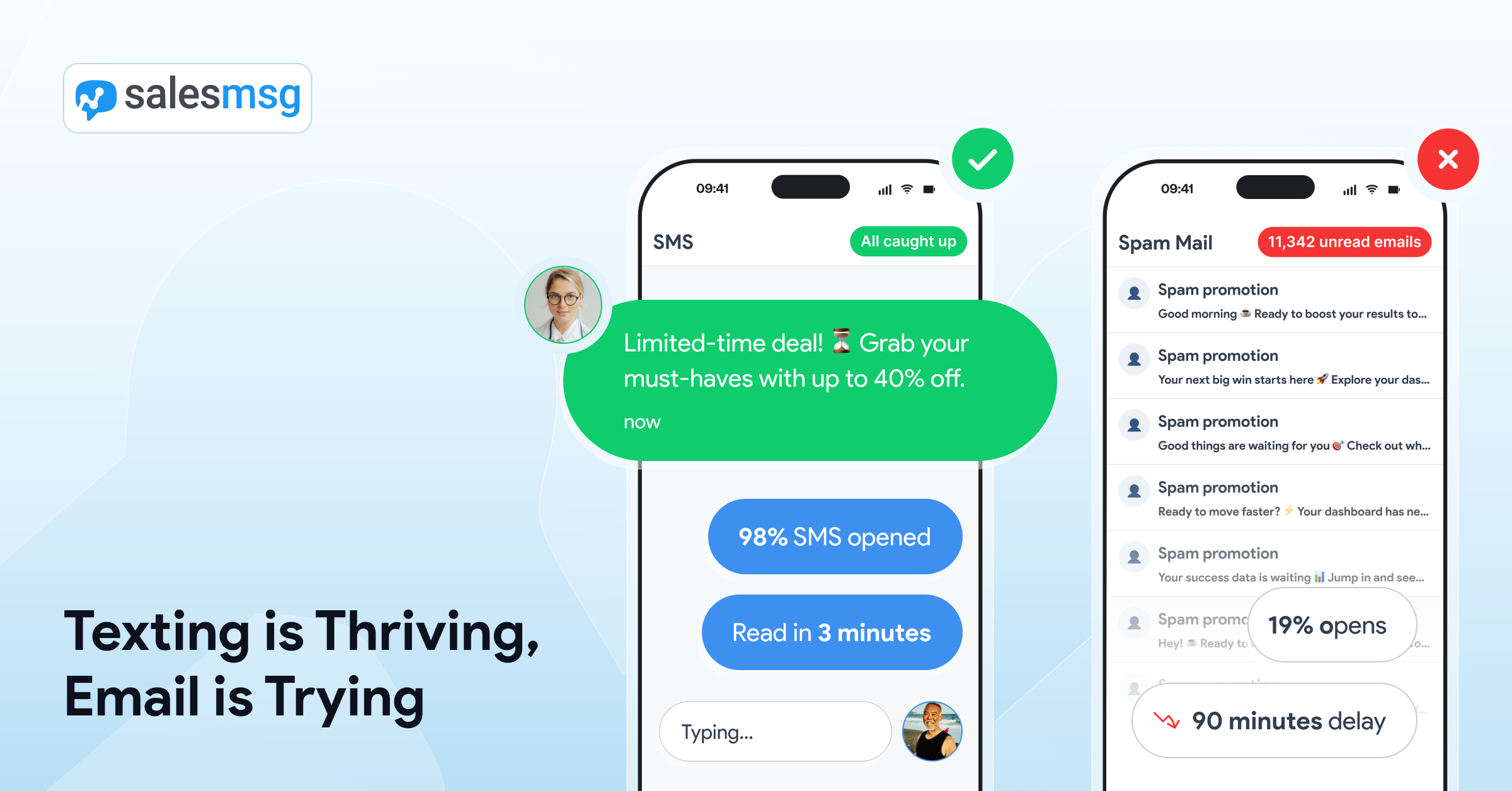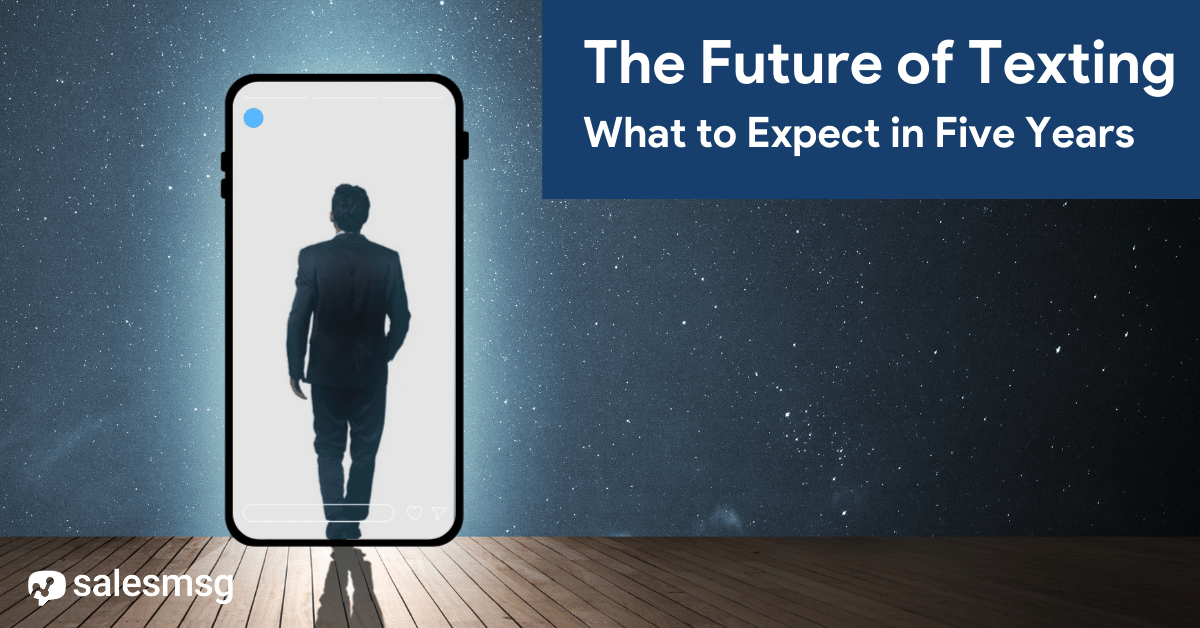Why Smart Businesses Integrate SMS Strategies

If your emails feel like they disappear before anyone sees them, you’re not alone. While email still matters for your brand, the truth is that it no longer moves fast enough on its own. Overfilled inboxes and slow responses, makes it tougher to rely on email for anything time sensitive. Validation tools help maintain list health, but they can’t speed up how quickly people read.
That challenge is why more companies pair email with texting instead of depending on a single channel. SMS keeps conversations moving in real time while email provides deeper touchpoints, giving teams a communication mix that reaches people at the right moment. So if you haven’t integrated SMS marketing yet, read on because you might be missing out, big time.
The Data That Proves SMS Has Taken the Lead
Many teams already feel the slowdown in email before they ever look at the numbers, but the data makes the gap impossible to ignore. Texts are seen and acted on at a pace that helps businesses keep momentum instead of waiting for inbox delays. The side-by-side results below give you a clear view of how each channel performs so you can decide where speed and response rates matter most.

Texting Versus Email
The numbers only tell part of the picture. What matters is how this shift affects day to day results for teams and businesses. Faster visibility changes how quickly customers respond, how soon revenue is generated, and how much effort it takes to stay connected. To make the data useful, it helps to break down what this change impacts across the areas that drive growth and efficiency.
Action
Most SMS messages are read within minutes. Open rates often sit near 98%, which gives teams a dependable way to confirm appointments, increase attendance, and protect active conversations. Email averages around 28.6% depending on the industry, and many messages sit untouched until later in the day or later in the week. This slows follow-ups and customer support. Companies that depend on quick replies now move their time-sensitive steps to SMS while keeping email focused on longer-form communication.
Conversion
Automated SMS continues to deliver stronger click and purchase behavior than email campaigns. Reports show click rates ranging from 21 to 35% in texting, while email often stays below 4%. That difference has a direct impact on revenue from abandoned carts, trial reminders, and promotional triggers. Teams that want higher output from lifecycle flows are adding SMS to their automation stack.
Operations
Email delivery depends on list quality, sender reputation, and filtering rules, which adds more work to maintain performance. Many businesses rely on validation and enrichment tools to maintain useful contacts. Still, this doesn’t ensure fast engagement. SMS eliminates delays and offers clear delivery feedback. Some tools like Salesmsg even offer built-in compliance options. This helps teams maintain workflows without guessing where communication stalled.
Compliance
SMS requires registration and carrier-approved sending, especially in the United States under A2P 10DLC and TCPA rules. This protects deliverability and reduces blocked messages, but it also means businesses need the right provider and process. Teams that plan ahead can send confidently and maintain accurate records instead of dealing with failed messages or unexpected restrictions, especially with regional compliance.
CRMs
Teams see the strongest gains when texting sits inside the systems they use each day. Salesmsg connects with leading CRMs so every message, call, and follow-up becomes part of a unified workflow instead of a disconnected task. This gives marketers, sales teams, and customer support teams a clear view of each contact’s history while removing the manual steps that slow communication.
HubSpot users send texts from contacts, companies, deals, and tickets without switching between platforms. Messages log in real time, sequences run through automated workflows, and teams build reports that measure reply speed, booked meetings, and customer outcomes. These insights help teams guide their next actions with precision instead of guesswork.
Salesforce teams manage two-way texting, mass sends, timelines, and custom fields inside their existing objects. They use automated triggers to respond to form submissions, pipeline changes, and service events. Calling tools, routing, voicemail options, and inbox management all connect back to the CRM. This creates a single source of truth that keeps deals moving and reduces back-and-forth for customers.
Salesmsg supports additional CRMs as well, giving teams the flexibility to carry their communication strategy across tools while keeping a consistent workflow. Automated routing, shared inboxes, and multi-channel triggers help teams maintain stronger engagement without stacking extra platforms on top of each other. This connection between CRM activity and texting gives businesses a cleaner, faster way to manage conversations across the full customer lifecycle.
The Communications Gap Between Businesses and Consumers
Most people communicate in quick messages throughout the day and stay connected through their phones. They expect fast updates and answers without sorting through a crowded inbox.
On the other hand, many businesses still rely on longer messages and slower email cycles that no longer match how customers engage and respond. The impact shows up in performance data, starting with how often messages are actually seen.
SMS open rates leave email behind
Most texts get seen almost immediately, with open rates near 98%. Email sits closer to 29 to 36% and can get buried before anyone notices it. The difference affects reminders, time sensitive updates, and anything that depends on visibility.
Messages are read within minutes
About 90% of texts are read within a few minutes. Email can sit unopened for more than an hour, sometimes days or much longer. Faster viewing benefits bookings, replies, expiring offers, and any moment where delay creates drop offs in engagement.
SMS drives stronger click and conversion performance
Stats show that automated texting earns higher click rates and conversions than email in most activities. Typical SMS click rates range from 21 to 35%, while email often reaches only 1.5 to 3.25%. Some campaigns see conversion rates between 21 and 30% from SMS compared to roughly 0.07% from email.
Texts influence purchases more directly
Klaviyo found that 72% of consumers have completed a purchase after receiving a branded text, which shows how much real-time communication shapes buying behaviour. Customers move through decisions faster when the message reaches them at the exact moment they are ready to act. A short reminder, a deadline update, or a restock alert reaches the phone they already check throughout the day, so the path to checkout feels smoother and more immediate.
Businesses feel this difference in daily results. Email can support research and longer explanations, but a text can turn interest into action in seconds. This consistency gives teams a reliable way to lift conversions during key moments in the funnel, especially for reminders, product notices, and offers tied to clear timeframes. As more buyers respond to short, direct communication, SMS strengthens the link between intent and completed revenue
SMS produces meaningful returns
Texting creates a bigger impact per send in many cases. SMS returns have ranged from $21 to $71 for every dollar spent. Email averages around thirty six dollars for every dollar. Email still scales well for long form communication, but texting delivers efficiency when response speed matters.
When Quiet Leads Start Responding Again
Email-based win-back efforts often lose momentum after the first attempt. Opens drop off, clicks shrink, and contacts who once engaged stop reacting even when the timing or offer still makes sense. Industry coverage reflects the same challenge. Once someone tunes out of email, filters and long gaps between touches work against the sender, which makes it difficult to restart a conversation through the same thread or channel.
Teams that add texting to re-engagement sequences see a different pattern. G2 feedback points to situations where a short message reaches someone who ignored email for weeks and they reply right away. Broader roundups support the same insight, labelling SMS as the most reliable way to wake up leads that went silent. A single text restores momentum without rebuilding the entire workflow, which proves that timing and delivery matter just as much as the message itself. It’s not just the medium - it’s the message too.
Why Email Alone Can’t Meet Today’s Business Demands
Relying on email as the only channel has become harder. Inbox volume increases every year, spam filters get picky, all of which means messages take longer to get seen. Some don’t get seen at all. Inbox volume increases every year and spam restrictions grow stricter, which slows down how quickly messages get seen. This slowdown impacts day-to-day operations because teams can no longer count on fast responses through email alone.
Email performance also changes from one industry to another. Benchmarks from Mailchimp show wide swings in open and click rates across categories. That level of inconsistency creates friction for sales, customer service, and retention workflows. When a business cannot predict how quickly people will respond, planning becomes more complicated.
Email still plays an important role for longer messages and detailed communication. Newsletters, onboarding guides, and multi-step updates work well in an inbox. The challenge shows up when a business needs quick action. Data from Omnisend highlights that automated SMS outperforms email in reminders, abandoned carts, and transactional flows because the delay between send and response is shorter.
Why Texting Has Become a High-Velocity Channel
Customers reply to short messages without overthinking. A text removes extra steps and creates forward momentum in a way email struggles to match. This simplicity helps teams keep deals, appointments, and customer support conversations active without waiting for a follow-up that may never arrive.
Most people check their phones throughout the day, so texts reach them faster than inbox-based communication. Even without internet access, SMS still gets delivered. That level of accessibility transcends engagement across different regions, age groups, professions and use cases, which gives businesses a more dependable path when timing matters.
How Smart Businesses Use SMS to Strengthen Their Entire Lifecycle Funnel
SMS helps teams stay connected across every stage of the customer journey without slowing down. When paired with email and automation, it supports faster responses, clearer communication, and steadier progress from first touch through acquisitions and retention.
Lead engagement and qualification
Texting reaches new leads before they drift away. Teams book more meetings because people reply faster to short messages than to inbox requests. This reduces the time between interest and conversation, which raises the number of confirmed appointments and keeps the pipeline active.
Transactional and lifecycle automation
Automated texts give customers the updates they actually check. Shipping notifications reach them in real time. Appointment reminders reduce no-shows because the message arrives in the channel they pay attention to. Abandoned cart texts recover lost revenue by prompting action before the customer forgets.
Marketing promotions and flash campaigns
Broadcast texts help time-sensitive campaigns perform better. Higher click rates mean more customers see the offer while it still matters. Brands also rely on SMS when they cannot risk emails getting buried or routed into a folder that slows momentum.
Customer support and post-purchase resolutions
Two-way texting helps teams solve issues without long back-and-forth threads. Customers get answers quickly, which lowers frustration and shortens ticket handling times. This reduces call volume and creates smoother follow-ups after a purchase or service visit.
Compliance-sensitive messaging with proper safeguards
Growth in texting has increased regulatory attention. Companies now need tools that manage consent, opt-outs, local requirements, and carrier rules without manual effort. Using a compliant platform helps businesses protect deliverability and customer trust while scaling responsibly.
The Role of Email in a Modern Marketing Mix
Email still plays a valuable part in communication when teams need space to explain something fully. It supports product education, newsletters, and detailed updates that require links, assets, or long-form context. Customers expect this type of content in their inbox, which makes email the right channel when clarity depends on more than a sentence or two.
SMS supports email by filling the gaps that timing and visibility create. Texts reach customers quickly while email provides the depth that helps them understand and decide. When both channels work together, brands stay present without overwhelming their audience. A short text can confirm an appointment or bring someone back to a campaign while email handles the full announcement, follow-up details, or next steps. This mix creates steady engagement across the entire journey because every message lands in the format customers are most likely to notice and use.
What the Trends Show for 2025 and Beyond
Businesses across e-commerce and retail continue to increase their use of texting because it delivers results without waiting on inbox timing. More brands now pair SMS with their existing systems to reach customers during key buying moments, and adoption keeps rising as teams see how quickly replies come through. Branded messaging and RCS are also gaining ground, giving companies richer ways to communicate without relying on apps.
Customers still prefer fast updates that fit into their day, and that behaviour is not slowing down. Teams need immediate engagement for order changes, scheduling, and follow-through, which keeps SMS at the centre of action-driven communication. Email remains part of the mix, but texting holds the advantage when a decision or response influences revenue in real time.
The Takeaway for Growing Companies
Brands that want consistent performance need channels that support quick action. SMS gives teams the speed that email no longer guarantees on its own. This shift improves replies, conversions, and customer communication throughout the entire lifecycle. When both channels work together, customers stay informed without waiting on inbox timing and every message reaches them with fewer delays.
Companies that add SMS see stronger sales momentum, smoother customer conversations, and better retention because outreach no longer slows down in busy inboxes. These gains expand even further when texting connects directly to their CRM. Salesmsg supports integrations with major platforms like HubSpot and Salesforce along with other CRMs. Teams can text from contact records, track message history, and trigger automated workflows that keep follow-ups on schedule. This removes manual steps, strengthens account visibility, and helps every department work from the same source of truth.
Growth becomes easier when SMS, email, and CRM data move together. The final step is choosing a platform that can support two-way messaging, automation, and compliance so teams stay focused on results instead of troubleshooting communication gaps.




















